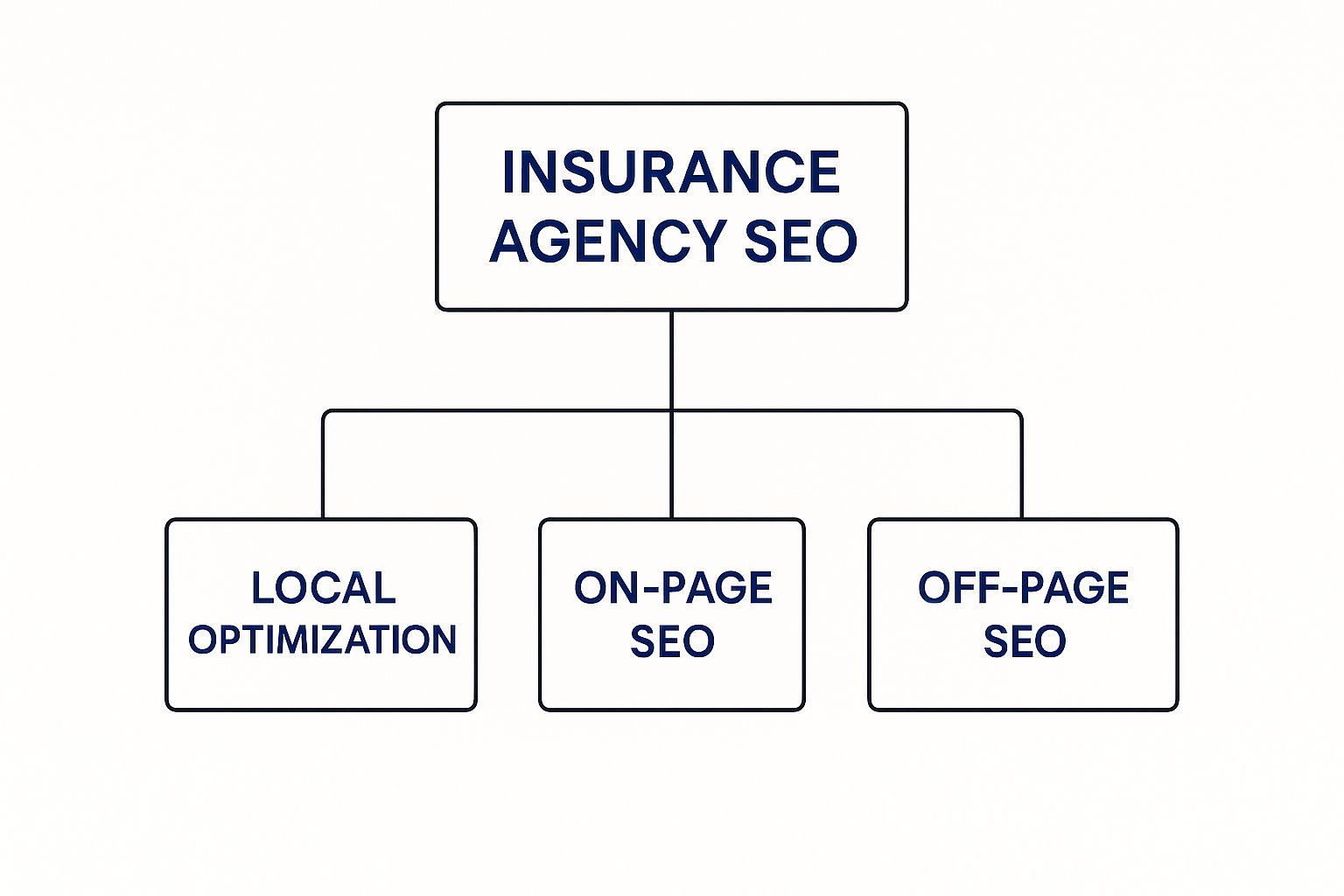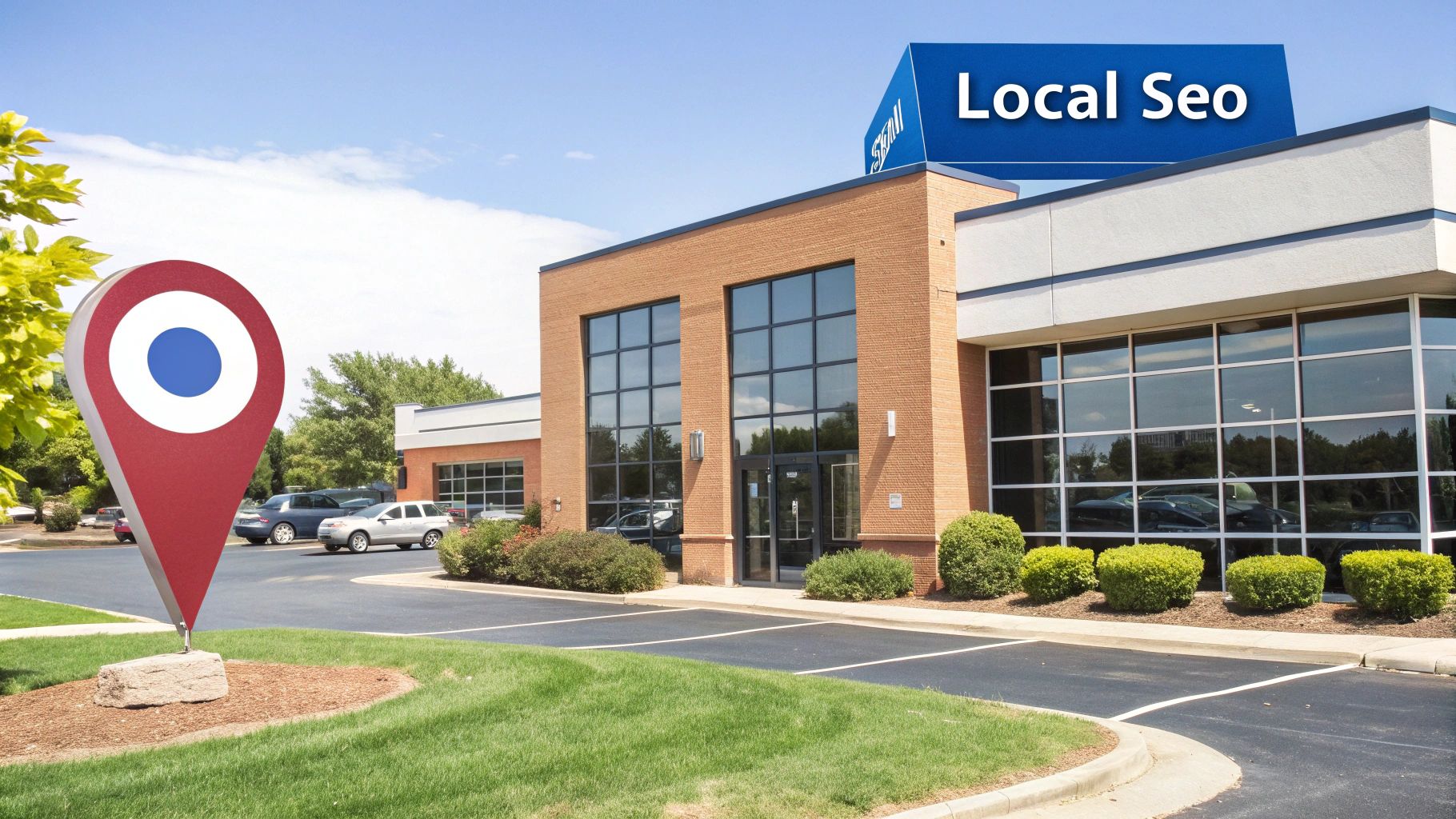Search Engine Optimization (SEO) for insurance agencies is the strategic process of ensuring your firm appears at the exact moment a potential client—be it a risk manager, underwriter, or business owner—searches online for coverage. For decision-makers in the commercial insurance and climate risk sectors, effective SEO is not about website traffic; it is about capturing qualified, high-intent leads actively seeking the risk management solutions you provide.
Building Your SEO Foundation
Before implementing advanced tactics, establishing a solid foundation is critical. Effective SEO is a methodical process, not a singular solution. It begins with a clear assessment of your current digital presence, the establishment of precise business goals, and the implementation of tools to measure performance. This foundational work ensures every subsequent action is strategic and contributes directly to revenue growth.
A successful SEO strategy is built on several core pillars that must function cohesively.

Image
This structure is hierarchical. A strong local search presence, a technically sound website, and broad digital authority are interdependent. A clear understanding of each component's objective is necessary for successful execution.
The Four Pillars of Insurance SEO
| SEO Pillar | Objective for Insurance Agencies | Example Activity |
|---|---|---|
| Technical SEO | Ensure search engines can efficiently crawl, index, and comprehend your website's architecture. | Resolving broken links, improving site load speed, and implementing a logical sitemap. |
| On-Page SEO | Optimize individual page content to signal relevance for specific, high-value commercial keywords. | Crafting targeted title tags and meta descriptions for a commercial liability insurance page. |
| Local SEO | Achieve top search rankings for prospective clients within your designated geographic service areas. | Optimizing your Google Business Profile and actively generating local client reviews. |
| Off-Page SEO | Build your agency's authority and credibility as a trusted resource within the insurance industry. | Earning high-quality backlinks from reputable insurance, finance, and business publications. |
Each pillar is essential for a sustainable strategy. Neglecting one will invariably weaken the others, making a balanced approach critical for long-term success.
Conducting a Baseline Digital Audit
To begin, you must conduct a thorough assessment of your current digital standing. An audit serves as your baseline, identifying critical weaknesses and immediate opportunities. You cannot map a route to your destination without knowing your starting point.
This process involves analyzing several key areas:
- Current Keyword Rankings: Determine your visibility for essential terms such as "commercial property insurance in [your city]." A lack of ranking means you are invisible to potential clients.
- Website Performance: Evaluate your site's load speed and mobile responsiveness. These are significant ranking factors for search engines.
- Online Reputation: Assess client reviews and online sentiment. A pattern of negative reviews—or a complete absence of them—is a significant deterrent for prospective clients.
- Competitor Analysis: Identify the top-ranking firms in your market. Analyze their strengths and, more importantly, identify strategic gaps you can exploit.
Setting Business-Focused SEO Goals
Avoid vague objectives like "increase website traffic." SEO goals must be specific, measurable, and directly tied to your agency's business objectives. This is how you connect marketing activity to revenue targets.
A well-defined SEO goal is not a marketing metric; it is a business objective. Instead of aiming for 'higher rankings,' aim to 'increase qualified quote requests from manufacturing businesses in Harris County by 15% within six months.'
Examples of actionable goals include:
- Increase organic traffic to high-value commercial lines pages by 25% this quarter.
- Achieve a top-three ranking in the local map pack for "business liability insurance" in our primary service area.
- Generate 10 new leads per month for climate risk advisory services through our content platform.
Implementing Core Tracking Tools
Data is required to measure progress. Two essential, no-cost tools from Google are non-negotiable for any serious SEO initiative.
Google Analytics is the primary tool for understanding user behavior on your website. It answers critical questions: Which service pages are most effective? What is the conversion rate of our online quote form? Which channels drive the most valuable traffic? This data enables you to identify which marketing efforts generate revenue.
Google Search Console provides direct insight into how Google views your site. You can identify the search queries driving traffic, uncover technical issues harming your rankings, and receive a comprehensive performance report. For further insights on leveraging technology, explore these resources for insurtech professionals.
Implementing these tools from the outset transforms SEO from a speculative activity into a predictable engine for business growth.
Uncovering High-Value Insurance Keywords

Image
Keyword strategy is the most critical element of insurance agency SEO. Success is not defined by ranking for vanity terms like "insurance," but by appearing precisely when your ideal client searches for a specific solution.
Effective keyword targeting allows you to move beyond generic queries and capture high-intent leads—decision-makers who are actively seeking the solutions you provide and are closer to requesting a quote.
The era of walk-in clients and phone book listings is over. The majority of insurance clients begin their search online. Your visibility in these search results determines whether they find your agency or a competitor, making organic search a highly sustainable and cost-effective channel for lead generation.
Moving Beyond Broad Keywords
A common mistake is targeting broad, high-volume keywords. A term like "business insurance" generates significant search volume, but the user's intent is unclear. The searcher could be a student conducting research or a real estate developer requiring a multi-million dollar policy.
This ambiguity results in low-quality traffic and poor conversion rates.
The most valuable opportunities lie in long-tail keywords. These are longer, more descriptive phrases that reveal the searcher's specific needs.
- Broad Keyword: "liability insurance"
- High-Intent Long-Tail Keyword: "liability insurance for contractors in Dallas TX"
The second searcher has a specific need (liability coverage), a defined industry (contractors), and a clear location (Dallas). This is not a research query; it is a qualified lead.
By focusing on long-tail keywords, you filter out irrelevant traffic and connect directly with prospects who have a defined problem you can solve. Your conversion rate from this traffic will be exponentially higher.
Mapping Keywords to the Client Journey
A prospective client's mindset evolves from problem awareness to purchase-readiness. Your keyword strategy must address each stage of this journey to build trust and position your agency as the definitive resource.
- Informational Stage: The prospect is defining their problem, using queries like, "what is umbrella insurance for a small business" or "how much commercial flood insurance do I need." Your objective is to provide clear, authoritative answers through blog posts and guides, establishing your expertise.
- Consideration Stage: The prospect is evaluating options. Searches become more specific: "best homeowners insurance for coastal properties" or "Allstate vs. Travelers commercial auto insurance." This stage is ideal for comparison guides, case studies, and detailed service breakdowns.
- Decision Stage: The prospect is prepared to act. Keywords become transactional: "get a free auto insurance quote online" or "commercial insurance broker near me." These terms must lead directly to contact pages and quote forms.
Mapping keywords in this manner ensures your content is available at the precise moment a prospect requires it. To execute this, follow a step-by-step guide to keyword research to build a repeatable process.
Analyzing Your Competitors for Gaps
Your competitors have already invested in keyword research. Use this to your advantage.
SEO tools allow you to analyze which keywords drive the most valuable traffic to their websites. Identify high-intent terms for which they rank but have underdeveloped content. If their corresponding blog post or service page is superficial, outdated, or unhelpful, you have found a strategic opportunity.
By creating a resource that is substantially more comprehensive and valuable, you can systematically capture that market share.
Optimizing Your Agency Website for Search Engines

Image
Once you have identified high-intent keywords, you must integrate them into your website's architecture. This transforms your site from a static digital brochure into a dynamic lead-generation asset.
The dual objective is to send clear relevance signals to search engines while providing a seamless, valuable experience for risk managers and business owners. This requires balancing keyword integration with a professional, authoritative tone.
Mastering On-Page SEO Elements
On-page SEO involves optimizing the visible and underlying elements of your website—content, headlines, and HTML code. These elements are your primary means of communicating to Google what each page is about and for which queries it should rank.
Focus on these critical signals first:
- Title Tags: This is your page's headline in search results. It must be under 60 characters, include the primary keyword, and provide a compelling reason to click. A page targeting coastal properties could use: "Coastal Property Risk Management | [Your Agency Name]". This is direct and effective.
- Meta Descriptions: This is the text snippet below the title tag. While not a direct ranking factor, a well-written description (under 160 characters) serves as your sales pitch, convincing users to choose your link over competitors'. It should state the value proposition and include a clear call to action.
- Service Page Content: The content must fulfill the promise of the keyword. A user searching for "cyber liability insurance for healthcare" must land on a comprehensive resource that covers the specific risks, coverage details, and compliance requirements unique to that industry.
The Strategic Value of Internal Linking
Internal links, which connect one page on your site to another, are a powerful and often underutilized SEO tool. They distribute authority throughout your website and guide potential clients through your sales funnel.
For example, linking from a popular blog post about recent hurricane activity to your commercial flood insurance service page creates a logical pathway for an engaged reader. This action also signals to Google that your flood insurance page is an important resource, helping it rank higher for relevant terms.
An intelligent internal linking strategy does more than improve SEO; it creates a clear journey for your prospects, guiding them from initial risk awareness directly to the specific solution your agency provides.
Demystifying Technical SEO for Agencies
Technical SEO ensures your website's foundation is sound, allowing search engines to crawl, understand, and index your content efficiently. Agency principals do not need to be technical experts but should focus on a few high-impact areas.
Prioritizing Website Performance and Security
Site speed and security are no longer optional; they are fundamental requirements. A slow or non-secure website creates a poor user experience, which search engines penalize.
- Site Speed: If your page takes more than three seconds to load, you are losing potential clients. Use Google's PageSpeed Insights to benchmark your performance and identify issues like large images or inefficient code. A faster site improves engagement and lead conversion.
- Mobile-Friendliness: Most B2B research now begins on a mobile device. Your website must function flawlessly on all screen sizes. If a risk manager cannot easily navigate your site on their smartphone, you have lost a potential lead.
- HTTPS Security: The padlock icon in the browser's address bar is a critical trust signal. An SSL certificate (which enables "https://") encrypts data and is a confirmed Google ranking factor.
Using Structured Data for a Competitive Edge
Structured data, or Schema markup, is code added to your site to help search engines understand your content at a deeper level. This can result in enhanced search results, known as "rich snippets," that make your agency stand out.
For an insurance agency, this could mean displaying:
- Star ratings aggregated from client reviews.
- An FAQ section directly in the search results.
- Your agency's address and phone number, facilitating immediate local contact.
These enhancements increase visibility, attract attention, and can significantly improve click-through rates. To understand how data can further refine your strategy, see our guide on real-time data analytics.
Dominating Local Search to Win Nearby Clients
For most insurance agencies, business growth is achieved locally, not nationally. Mastering local SEO ensures that when a business owner in your service area needs coverage, your agency is the first one they find. This is about establishing dominance in your local market.
A critical component is your Google Business Profile. Learning how to start optimizing your Google My Business profile is non-negotiable for attracting local clients. It functions as your digital storefront on Google and is often the first impression a potential client has of your firm.
Fine-Tuning Your Google Business Profile
An incomplete Google Business Profile (GBP) represents a significant missed opportunity. Every section must be completed with precision to signal professionalism to both Google and potential clients.
Focus your immediate attention here:
- Service Categories: Do not settle for "Insurance Agency." Be specific. Use primary and secondary categories like "Commercial Insurance Agency," "Auto Insurance Agency," or "Homeowners Insurance Agency" to clearly define your specializations.
- High-Quality Photos: Invest in professional photography of your office, your team, and your engagement in local community events. Photos build trust and humanize your business.
- Services Offered: Utilize the "Services" feature to list every policy type you offer, from "General Liability" to "Workers' Compensation." Each service entry allows for a description, providing another opportunity to integrate relevant keywords.
The image below shows the dashboard for managing these critical details.

Image
This is the control center for your local presence, dictating how clients see and interact with your agency on Google Search and Maps.
Keeping Your Citations Consistent
Beyond your GBP, Google seeks consistent information about your agency across the web. A "citation" is any online mention of your agency's Name, Address, and Phone number (NAP). Minor discrepancies, such as using "St." in one directory and "Street" in another, can confuse search engines and negatively impact your local rankings.
Ensure your NAP information is 100% identical across all online platforms, including:
- Yelp
- Your local Chamber of Commerce website
- Industry-specific directories
- All social media profiles
Consistency acts as a powerful trust signal, reinforcing your identity and location.
A consistent NAP across the web functions as a series of digital verifications for search engines. It confirms your identity and location—both of which are essential for achieving high rankings in local search results.
Building a Steady Stream of Positive Reviews
Reviews are a major local ranking factor and a powerful conversion tool. A consistent flow of recent, positive reviews signals to Google that your business is active and trusted. Furthermore, 88% of consumers trust online reviews as much as personal recommendations.
Implement a simple, repeatable process for requesting reviews from satisfied clients, such as an automated email sent one week after a policy is finalized. For more strategies on converting interactions into business, see our guide on lead generation for insurance agents.
Creating Hyper-Targeted Local Service Pages
To capture the most motivated local searchers, develop dedicated website pages for your core services in specific geographic locations. Do not rely on a single, generic "Commercial Auto Insurance" page.
Instead, create targeted pages such as:
- "Commercial Auto Insurance in San Diego"
- "Contractors Liability Insurance in Austin"
- "Restaurant Insurance Broker in Miami"
These pages allow you to incorporate hyper-local details, client case studies, and specific testimonials. This sends an unmistakable signal to Google that you are the authority for that service in that city, enabling you to capture high-intent leads.
Building Authority Through Content and Backlinks
Search rankings reflect your agency's authority in the marketplace. To succeed on Google, you must be perceived as a leading expert. This is achieved through a two-part strategy: creating high-value, problem-solving content and earning endorsements (backlinks) from other reputable websites.
This approach requires a mindset shift from vendor to strategic advisor. It involves developing content that addresses the real-world challenges of your clients and actively building relationships to secure inbound links.
Developing Content That Builds Credibility
The most effective content for an insurance agency answers the complex, specific questions that your ideal clients face. Your blog should not contain generic articles but serve as a critical resource for risk managers and business owners.
Address the nuanced topics that are top-of-mind for your clients:
- Detailed Guides: Instead of simply stating you handle claims, create a comprehensive guide to navigating the claims process following a major flood or data breach. Demonstrate your expertise.
- Hyper-Local Case Studies: Feature a local client, such as a contractor or manufacturer. Detail the specific risk they faced, the solution you engineered, and the business outcome. Authentic success stories build trust.
- Expert Q&As: Address the complex questions your producers receive daily. For example, "What are the key differences in liability coverage for a technology startup versus an established consulting firm?"
Content of this caliber acts as a magnet for qualified prospects seeking your expertise. When executed correctly, it becomes the cornerstone of your lead generation system, a concept we explore in our guide to [inbound marketing and lead generation](https://insurtech.bpcorp.eu/blog/inbound-marketing-lead-generation-1753007394603).
A Practical Approach to Earning Backlinks
While quality content is the foundation, backlinks—links from other websites to yours—provide the external validation that Google values. A backlink from a respected source is a vote of confidence in your expertise. Acquiring these links requires a proactive, relationship-driven strategy.
Effective link-building is about creating value for others. You must provide a compelling reason for another organization to feature your agency. This means becoming a visible, contributing member of your professional and local communities.
A high-quality backlink profile is one of the strongest signals you can send to Google that your agency is a legitimate and trustworthy authority. Each link from a reputable source compounds your credibility and pushes you higher in search rankings.
Here are several ethical, high-impact methods for earning valuable backlinks:
- Sponsor Local Events: Sponsoring a local business conference or community charity event typically results in a link from the event's website. This provides a quality backlink while reinforcing your local presence.
- Contribute Expert Commentary: Local business journals, financial blogs, and industry trade publications constantly seek expert sources. Offer your insights on risk management trends or new insurance regulations to get quoted and earn authoritative backlinks.
- Create Link-Worthy Local Resources: Develop a genuinely useful asset that other local businesses will want to link to. This could be a "Guide to Business Permitting in [Your City]" or a "Disaster Preparedness Checklist for [Your County] Businesses."
The insurance agency SEO landscape is increasingly specialized, with firms focusing on niches like commercial property, auto, or health. An analysis of top SEO agencies revealed that this specialization is a key determinant of their success, underscoring the importance of building authority in your specific niche. You can [discover more about these findings](https://firstpagesage.com/seo-blog/the-top-insurance-seo-agencies/) to benchmark against competitors.
By combining expert-level content with a strategic outreach plan for backlinks, you create a powerful flywheel effect. The content proves your authority, and that authority helps you earn the backlinks that solidify your position in Google's rankings.
Frequently Asked Questions About Insurance SEO
Even with a well-defined strategy, questions will arise. The following are direct answers to the most common queries we receive regarding SEO for insurance agencies.
How Long Does SEO Take to Produce Results?
This is a critical question. SEO is a long-term strategy for building a valuable business asset, not a tactic for generating immediate leads.
For a new website or one with no prior SEO, expect to see a significant increase in rankings and organic leads within six to twelve months. For an agency with an established website that is just beginning a focused SEO initiative, meaningful results can often be seen in four to six months.
The timeline is influenced by several factors:
- Market Competition: Ranking in a major metropolitan area like Dallas is more competitive and requires more time than ranking in a smaller market.
- Website History: An established domain with some authority typically gains traction faster than a brand-new site.
- Resource Commitment: The speed of results is directly proportional to the consistency and quality of your content creation, link building, and on-page optimization efforts.
Think of SEO as a long-term investment. The work you do today builds the foundation for a sustainable, lead-generating asset for years to come. Patience and consistency are paramount.
What Is More Important: Content or Backlinks?
This is a false choice; both are essential and interdependent. One without the other is ineffective.
Content is the foundation. Without expert-level articles, guides, and service pages that solve your clients' problems, Google has nothing of substance to rank. Content is how you demonstrate authority on niche topics like "commercial property insurance for coastal businesses" or "cyber liability for healthcare providers."
Backlinks are the validation. They are votes of confidence from other websites. When a respected business journal or industry association links to your content, it sends a powerful signal to Google that you are a trustworthy source. You can create the world's best content, but without backlinks, it will have limited visibility.
Ultimately, great content attracts great backlinks. By creating genuinely useful resources, other sites will be naturally inclined to share them, creating a virtuous cycle.
Should I Do SEO Myself or Hire an Agency?
This decision depends on your team's available time, expertise, and resources.
| Aspect | The DIY Approach | Partnering with an Agency |
|---|---|---|
| Cost | Lower upfront cash outlay, but the opportunity cost of your time is significant. | A direct investment that secures specialized expertise and typically yields faster, more substantial results. |
| Expertise | Requires a steep learning curve in technical SEO, content strategy, and link building—all full-time disciplines. | Provides immediate access to a team of specialists who are current on all algorithm updates and best practices. |
| Time | SEO is extremely time-consuming and will divert focus from core business functions like client service and agency management. | Frees up your internal team to focus on their primary responsibilities while experts manage your online growth. |
| Tools | Professional-grade SEO tools are expensive, with subscriptions often costing hundreds of dollars per month. | Agencies provide access to a suite of enterprise-level tools, offering data and insights that are otherwise inaccessible. |
A DIY approach can work if you have a dedicated marketing professional on staff with the time to commit. However, for most agencies focused on growth, partnering with a specialized insurance agency SEO firm is the most direct path to achieving business objectives without the associated operational burden.
We've addressed the most pressing questions agency owners have about SEO. Below are a few more quick answers.
Frequently Asked Questions
| Question | Answer |
|---|---|
| What is the first step in an SEO strategy? | Begin with a comprehensive technical audit of your website. A solid foundation is required before building upon it. Address any crawling or indexing issues first. |
| How many blog posts should we publish per month? | Prioritize quality over quantity. For most agencies, 2-4 high-quality, in-depth posts per month is a sustainable and effective target. Consistency is more important than volume. |
| Is social media part of SEO? | Indirectly. While social media shares are not a direct ranking factor, a strong social presence increases visibility, which can lead to backlinks and drive website traffic—both of which directly support SEO goals. |
| Do I need to rank #1 to get leads? | No. While ranking #1 is ideal, achieving a position in the top 3-5 for valuable, high-intent keywords will generate significant traffic and qualified leads. The objective is visibility to the right audience. |
This information should clarify the process of implementing a successful SEO strategy. SEO is not a mystery; it is a proven methodology for building a predictable pipeline of inbound leads.
---
At Insurtech.bpcorp.eu, we turn climate-driven events into actionable business intelligence. While you focus on building your online authority through SEO, our Sentinel Shield platform delivers high-intent commercial leads directly to you when they need help the most—in the immediate aftermath of a flood, storm, or wildfire. We identify exposed businesses, enrich their profiles with decision-maker contacts, and deliver CRM-ready opportunities within 24 hours.